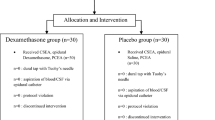Abstract
Background
Obstetrical analgesia continues to be challenging to science in the search for safe and effective methods that will permit the use of these procedures allied to improved obstetrical and perinatal results.
Objective
The objective of the present study was to investigate the pharmacokinetics and the placental transfer of lidocaine and its metabolite in parturients whose pregnancies were resolved by the vaginal route under perineal analgesia.
Patients and methods
The study was conducted on 23 pregnant women who received perineal analgesia with 20 ml 2% lidocaine (400 mg) during the expulsive period of labor. Maternal venous blood samples were obtained from 0 min to 360 min after drug administration, and umbilical venous blood was obtained at delivery. Lidocaine and monoethylglycinexylidide (MEGX) were determined using high-performance liquid chromatography. The fetal/maternal ratios of the drugs were determined on the basis of maternal and fetal concentrations at delivery.
Results
Maximum lidocaine concentrations at the median times of 15 min were 3.22 μg/ml. The pharmacokinetic parameters were: half-life t 1/2α 24.0 min, area under the curve (AUC) 0-∞ 460.2 μg/min per ml, t 1/2β 180.0 min, clearance 12.2 ml/min per kg and volume distribution 3.1 l/kg. The fetal/maternal ratio for lidocaine at delivery was 0.46, with the latency time between drug administration and delivery being 11.0 min. Maximum MEGX concentrations at the median time of 90 min were 229.0 ng/ml. The t 1/2 for MEGX was 240 min, and AUC0-∞ was 82.4 μg min/ml.
Conclusion
Lidocaine administered by the perineal route presented a tmax of 15 min, significantly lower than when the drug was administered peridurally, revealing that the time between administration and the occurrence of the analgesic effect was shorter. The study demonstrated placental transfer of lidocaine at ratios of about 50% for lidocaine at the time of delivery. The MEGX placental transfer demonstrated fetal concentration higher than the maternal at the time of delivery.

Similar content being viewed by others
References
Rathmell JP, Viscome CM, Ashburn MA (1997) Management of nonobstetric pain during pregnancy and lactation. Anesth Analg 85:1074–1087
Loebstein R, Lalkin A, Koren G (1997) Pharmacokinetic changes during pregnancy and their clinical relevance. Clin Pharmacokinet 33:328–343
Pasanen M, Pelkonen O (1990) Human placental xenobiotic and steroid biotransformations catalyzed by cytochrome P450, epoxide hydrolase, and glutathione s-transferase activities and their relationships to maternal cigarette smoking. Drug Metab Rev 21:427–446
Finster M, Pedersen H (1979) Placental transfer and fetal uptake of drugs. Br J Anaesth 51:25–28
Kennedy RL, Bell JU, Miller RP, Doshi D, Sousa H, Kennedy MJ, Heald DL, Bettinger R, David Y (1990) Uptake and distribution of lidocaine in fetal lambs. Anesthesiology 72:483–489
Isohanni MH, Neuronen PJ, Palkama VJ, Olkkola KT (1998) Effect of erythromycin and itraconazole on the pharmacokinetics of intravenous lignocaine. Eur J Clin Pharmacol 54:561–565
Sotaniemi EA, rautio A, Bäckstron M, Arvela P, Pelkonen O (1995) CYP3a4 and CYP2a6 activities marked by the metabolism of lignocaine and coumarin in patients with liver and kidney diseases and epileptic patients. Br J Clin Pharmacol 39:71–76
Wang JS, Backman J, Taavitsainen P, Neuvonen PJ, Kivisto KT (2000) Involvement of CYP1A2 and CYP3A4 in lidocaine N-deethylation and 3-hydroxylation in humans. Drug Metab Dispos 25:959–965
Orlando R, Picolli P, De Martin S, Padrini R, Palatini P (2003) Effect of the CYP3A4 inhibitor erythromycin on the pharmacokinetics of lignocaine and its pharmacologically active metabolites in subjects with normal and impaired liver function. Br J Clin Pharmacol 55:86–93
Kuhnert BR, Knapp DR, Kuhnert PM, Prochaka AL (1987) Maternal, fetal and neonatal metabolism of lidocaine. Clin Pharmacol Ther 26:213–220
Ala Kokko TI, Pienimaki P, Herva R, Hollmen AI, Pelkonen O, Vahakangas K (1995) Transfer of lidocaine and bupivacaine across the isolated perfused human placenta. Pharmacol Toxicol 77:142–148
Laroche N, Leneveu A, Roux A, Flouvat B (1998) Capillary gas chromatographic method for the measurement of small concentrations of monoethylglycinexylidide and lidocaine in plasma. J Chromatogr B 716:375–381
Philipson EH, Kuhnert BR, Syracuse CD (1984) Maternal, fetal, and neonatal lidocaine levels following local perineal infiltration. Am J Obstet Gynecol 15:403–407
Hardman JG, Limbird LE (2000) Goodman and Gilman’s: the pharmacological basis of therapeutics, 10th edn. McGraw-Hill Professional, International Edition, New York p 1975
Sawyer RJ, Von Schroeder H (2002) Temporary bilateral blindness after acute lidocaine toxicity. Anesth Analg 95:224–226
Scott DB (1986) Toxic effects of local anesthesia agents on the central nervous system. Br J Anaesth 58:732–735
Ramanathan J, Bottorff M, Jeter JN, Khalil M, Sibai BM (1986) The pharmacokinetics and maternal and neonatal effects of epidural lidocaine in preeclampsia. Anesth Analg 65:120–126
Downing JW, Johnson HV, Gonzalez HF, Arney TL, Herman NL, Johnson RF (1997) The pharmacokinetics of epidural lidocaine and bupivacaine during cesarean section. Anesth Analg 84:527–532
Nattel S, Gagne G, Pineau M (1987) The pharmacokinetics of lignocaine and β-adrenoreceptor antagonists in patients with acute myocardial infarction. Clin Pharmacokinet 13:293–316
Little BB (1999) Pharmacokinetics during pregnancy: evidence-based maternal dose formulation. Obstet Gynecol 93:858–868
Sakuma S, Oka T, Okuno A, Yoshioka H, Shimazu T, Ogawa H (1985) Placental transfer of lidocaine and elimination from newborns following obstetrical epidural and pudendal anesthesia. Pediatr Pharmacol 5:107–115
Banzai M, Sato S, Tezuka N, Komiya H, Chimura T, Hiroi M (1995) Placental transfer of lidocaine hydrochloride after prolonged continuous maternal intravenous administration. Can J Anaesth 42:338–340
Author information
Authors and Affiliations
Corresponding author
Rights and permissions
About this article
Cite this article
Cavalli, R.d., Lanchote, V.L., Duarte, G. et al. Pharmacokinetics and transplacental transfer of lidocaine and its metabolite for perineal analgesic assistance to pregnant women. Eur J Clin Pharmacol 60, 569–574 (2004). https://doi.org/10.1007/s00228-004-0798-0
Received:
Accepted:
Published:
Issue Date:
DOI: https://doi.org/10.1007/s00228-004-0798-0



